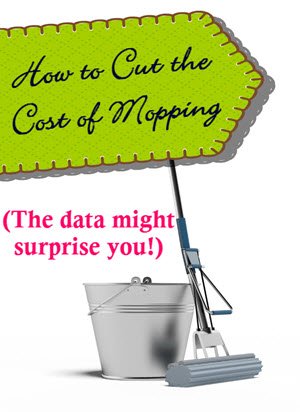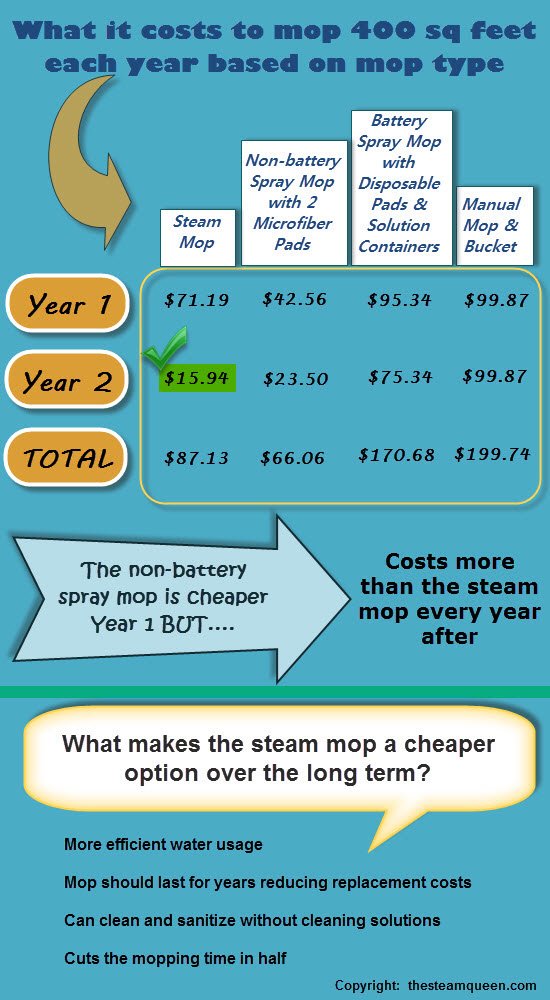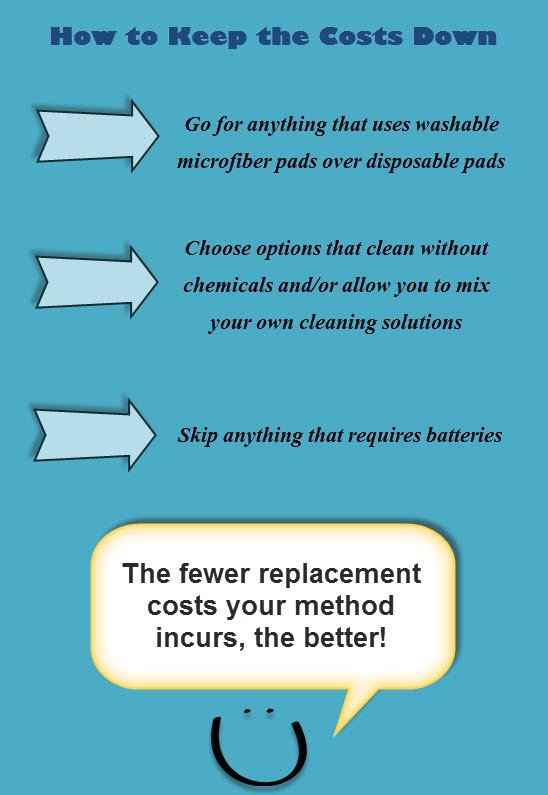Compare the Cost of Different Mop Types and Save
 Have you ever wondered how much you spend each year mopping the floors in your home? I compared the costs of different mop types to figure out the answer to that very question.
Have you ever wondered how much you spend each year mopping the floors in your home? I compared the costs of different mop types to figure out the answer to that very question.
In my calculations I included everything I could think of – water usage, cleaning solution costs, electricity used by steam mops, replacement costs for chemicals and pads and even the amount of time each method requires.
I know – sounds geeky, right? But I really am a spreadsheet addict and I like to dig into the facts so for me this was fun. (Yeah, I’m a blast at parties!)
Four mop types were included in the comparison:
- The old, manual mop and bucket of water method
- A non-battery spray mop that comes with 2, reusable, microfiber pads
- Popular battery-operated spray mop with disposable pads and cleaning solution containers
- Electric steam mop
Gathering this level of detail was part of a regular day for me in my corporate job so I do take this kind of data very seriously. Further down the page you’ll see what went into the calculations.

So, the old method of mopping costs almost $100/year and never sees any reduction in follow-up years because you have to replace those mops. They aren’t meant to last forever.
While the price of a steam mop is higher than the other types, it should last for many years thereby reducing your expense in future years making the purchase worthwhile. In terms of total costs for the first year, it’s still cheaper than either the mop and bucket or the battery powered option since no cleaning solution is required.
At first, it seems shocking that a cheap squeeze mop and a bucket of water with cleaning solution could cost as much as it does. In order to understand how this could be the case, think about how much water you end up pouring down the drain after each mopping session and how much extra cleaning solution was also in that water you didn’t use.
That’s a lot of waste that adds up over time, right? What the newer mops have done is to improve efficiency such that water usage and chemical waste are both reduced. Makes sense. That’s their edge!
Keep Mopping Costs to a Minimum
This understanding of how newer mops are cheaper to use than the old method of cleaning our floors can also be a trap. It highlights the benefits of switching to a new method but some of those newer mops are designed to make you buy a greater number of replacement items in order to continue using them.
This means that choosing a mop that requires as few replacement pieces as possible can help you keep your costs to a minimum.

Data and Assumptions Used in the Calculations
The costs were determined based on mopping a 20 x 20 foot area (or 400 square feet) once a week for a year. The expense for each method includes everything you have to use to operate the mop and complete the task including utility expenses.
The first year for each includes the cost to acquire the particular mop.
Cost to Operate a Floor Mop with Bucket
This option includes the cost of the mop and bucket in year 1, 2 gallons of water per mopping session at $.003 per gallon (an average cost for households in the US), 1/2 cup of cleaning solution (I used Pinesol to calculate the expense), and the need to replace the mop in year 2.
It doesn’t include – but should be counted as negatives – the fact that this method requires more physical effort than the other methods, takes longer, and can sometimes require you go through multiple buckets of water per session.
Cost to Operate a Non-Battery Spray Mop with Microfiber Pads
These mops are cheap and the microfiber pads should last a year. Replacement pads are also cheap. The mop includes a refillable bottle that holds your own cleaning solution.
This option includes the cost to buy the mop in year 1, water, cleaning solution, and replacement pads needed every 12 months.
Cost to Operate a Battery Spray Mop with Disposable Pads
Boy, the companies that make the battery mops with pads you have to keep buying are very smart. They hook you with their ease of use while putting in a direct line to your wallet.
This option includes what it costs to buy the original starting kit and mop, disposable pads to last a year, batteries (a total of 8 AA for the year), and 6.5 pre-filled cleaning solution bottles.
Cost to Operate a Steam Mop
The price of a steam mop is higher than the others but it should last longer and has the benefit of being able to clean and sanitize without any chemicals. I used the current price for one of the best rated, best-selling models available online.
This option also includes the cost of water used and electricity at an average expense of $.1047 per kilowatt hour with a device that operates at 1500 watts for 15 minutes to complete the mopping task. Added to each subsequent year was the cost of replacement microfiber pads.
What’s not included – but should count as a positive – is that this method takes the least amount of physical effort. The steam does most of the work.
Have You Switched to a Newer Mop?
Some people look at charts and can read them like a book while others will have their eyes glaze over. That’s okay. The main point is that when you compare the cost of different mop types the old bucket of water method is not as cheap nor as efficient as you may have thought. Newer mops are worth considering and then try to avoid the ones that make you buy lots of repeat products so you can save money, time, and have nice, clean floors.
